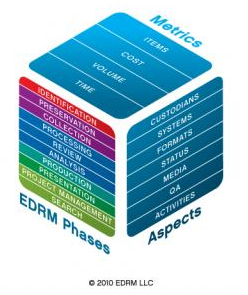eDiscovery Best Practices: Avoiding eDiscovery Nightmares: 10 Ways CEOs Can Sleep Easier

I found this article in the CIO Central blog on Forbes.com from Robert D. Brownstone – it’s a good summary of issues for organizations to consider so that they can avoid major eDiscovery nightmares. The author counts down his top ten list David Letterman style (clever!) to provide a nice easy to follow summary of the issues. Here’s a summary recap, with my ‘two cents’ on each item:
10. Less is more: The U.S. Supreme Court ruled unanimously in 2005 in the Arthur Andersen case that a “retention” policy is actually a destruction policy. It’s important to routinely dispose of old data that is no longer needed to have less data subject to discovery and just as important to know where that data resides. My two cents: A data map is a great way to keep track of where the data resides.
9. Sing Kumbaya: They may speak different languages, but you need to find a way to bridge the communication gap between Legal and IT to develop an effective litigation-preparedness program. My two cents: Require cross-training so that each department can understand the terms and concepts important to the other. And, don’t forget the records management folks!
8. Preserve or Perish: Assign the litigation hold protocol to one key person, either a lawyer or a C-level executive to decide when a litigation hold must be issued. Ensure an adequate process and memorialize steps taken – and not taken. My two cents: Memorialize is underlined because an organization that has a defined process and the documentation to back it up is much more likely to be given leeway in the courts than a company that doesn’t document its decisions.
7. Build the Three-Legged Stool: A successful eDiscovery approach involves knowledgeable people, great technology, and up-to-date written protocols. My two cents: Up-to-date written protocols are the first thing to slide when people get busy – don’t let it happen.
6. Preserve, Protect, Defend: Your techs need the knowledge to avoid altering metadata, maintain chain-of-custody information and limit access to a working copy for processing and review. My two cents: A good review platform will assist greatly in all three areas.
5. Natives Need Not Make You Restless: Consider exchanging files to be produced in their original/”native” formats to avoid huge out-of-pocket costs of converting thousands of files to image format. My two cents: Be sure to address how redactions will be handled as some parties prefer to image those while others prefer to agree to alter the natives to obscure that information.
4. Get M.A.D.? Then Get Even: Apply the Mutually Assured Destruction (M.A.D.) principle to agree with the other side to take off the table costly volumes of data, such as digital voicemails and back-up data created down the road. My two cents: That’s assuming, of course, you have the same levels of data. If one party has a lot more data than the other party, there may be no incentive for that party to agree to concessions.
3. Cooperate to Cull Aggressively and to Preserve Clawback Rights: Setting expectations regarding culling efforts and reaching a clawback agreement with opposing counsel enables each side to cull more aggressively to reduce eDiscovery costs. My two cents: Some parties will agree on search terms up front while others will feel that gives away case strategy, so the level of cooperation may vary from case to case.
2. QA/QC: Employ Quality Assurance (QA) tests throughout review to ensure a high accuracy rate, then perform Quality Control (QC) testing before the data goes out the door, building time in the schedule for that QC testing. Also, consider involving a search-methodology expert. My two cents: I cannot stress that last point enough – the ability to illustrate how you got from the large collection set to the smaller production set will be imperative to responding to any objections you may encounter to the produced set.
1. Never Drop Your Laptop Bag and Run: Dig in, learn as much as you can and start building repeatable, efficient approaches. My two cents: It’s the duty of your attorneys and providers to demonstrate competency in eDiscovery best practices. How will you know whether they have or not unless you develop that competency yourself?
So, what do you think? Are there other ways for CEOs to avoid eDiscovery nightmares? Please share any comments you might have or if you’d like to know more about a particular topic.








